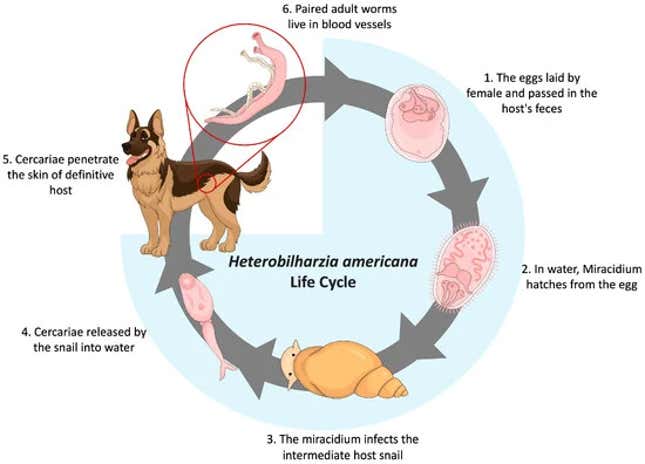An invasive, dog-killing parasite is now lurking in Southern California. In new research this week, scientists say they’ve confirmed the newfound spread of the flatworm Heterobilharzia americana to the area. The parasite is not thought to be a danger to humans, but it could become an emerging threat to pets and animals living along the lengthy Colorado River, the researchers say.
H. americana is one of many worm species nicknamed the liver fluke. Their immediate hosts are snails, which carry and release the larval, free-living form of the parasites into freshwater. Once these larvae come across their next compatible victim (also called a definitive host) in the water, they burrow their way in through the skin, migrating first to the lungs, the liver, and then certain blood vessels along the intestinal lining. From there, they mature into adults, mate, and lay eggs that are pooped out and intended to infect snails, starting the life cycle all over again. Raccoons are the primary definitive host of the species, but the worms can infect and lay eggs inside other mammals as well, including dogs and horses.

When these worms infect dogs, they cause a disease called canine schistosomiasis. Most of the harm caused by this infection doesn’t come from the worms that first invade the body, but the next generation of eggs they lay, which circulate through the bloodstream and can end up in the intestines and other organs. They then trigger inflammation and the formation of immune cell clusters called granulomas that can damage the body. Symptoms tend to be gradual at first, such as lethargy and weight loss, but without treatment, the infection can lead to life-threatening organ failure.
It was previously thought that the worms only had one species of snail that naturally served as an immediate host, Galba cubensis, but scientists have recently discovered at least two and possibly three other snail species that can carry it. Similarly, while cases of dog infection have historically been seen in parts of Texas and other states around the Gulf Coast, veterinarians and pet owners have now started to report cases elsewhere, including in California. From 2018 to 2023, 11 cases have been reported in the state, all from Southern California and all tied to dogs that had visited the Colorado River, which supplies up to a third of the area’s water.
Flatworms like H. americana aren’t normally the forte of study author Adler Dillman, a professor of nematology (the study of roundworms) at the University of California, Riverside. But he didn’t pass up the chance to investigate the mysterious arrival of these cases when his colleagues asked him for help.
Dillman and his team decided to look for H. americana in its presumed new hunting grounds. They went to regions of the river where dog cases had likely occurred and collected samples of snails that they took back to their lab, hoping to catch some worms right as they were about to be shed from the snails.
“It was kind of like looking for a needle in a haystack, since we were trying to pick up snails that had been infected around three weeks earlier…And when we saw [the worms], we were all jumping up and down excited taking pictures. It was a thrilling moment for us,” Dillman told Gizmodo. “But that’s bad news for people living in and around that area, because now there’s this parasite to be concerned about.”
The researchers also sequenced the DNA from the snails and worms, finding the clear presence of H. americana inside not one but two snail species, G. cubensis and Galba humilis—an unexpected discovery for multiple reasons.
“First of all, these snails haven’t been reported in the Colorado River before, certainly not this far south. And it was unusual for us to find both of these species co-occurring in the same place, which also hasn’t previously been reported,” Dillman said.
There are other species of worms that cause serious schistosomiasis in humans, but exposure to H. americana only seems to cause a mild skin rash at most. And the infection cannot be spread from dog to dog or from dogs to humans, only through direct contact with the worms in contaminated freshwater.
But the worms do seem to have become a larger risk to dogs and other animals than once assumed. There have been recently reported infections in other non-endemic areas of the country close to the Colorado River, so it’s very possible that the river is spreading the snails and the worms far and wide.
“This could be a much bigger problem—not just in Southern California, but Nevada, Utah, Colorado,” and the parts of New Mexico tied to the river, Dillman said.
Another unanswered question is exactly how these snails ended up in the river in the first place. “Climate change may be a factor, but human activity could also certainly be a factor as well. We just don’t know,” Dillman said.
For now, the scientists hope their work can help keep dogs and their owners safe from the parasite.
“It’s good to know that this is a possibility. And so you may want to go to a different place, you may not want to be in this part of the Colorado River. Or maybe you may just be able to keep a closer eye on your dog and know what the possible cause is of any illness that pops up,” Dillman said.
While Dillman mostly works with roundworms, he would like to keep studying H. americana if he can. Roundworms and the infections they cause are often used to learn more about how the immune system works, but there may be unique lessons that these and similar flatworms could teach us as well, he notes.




















+ There are no comments
Add yours